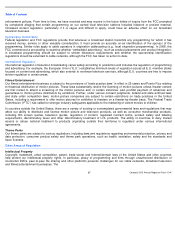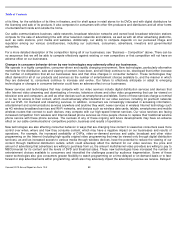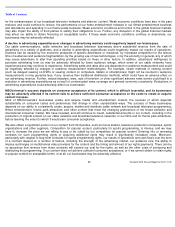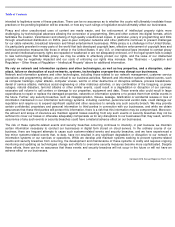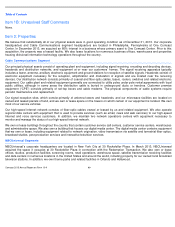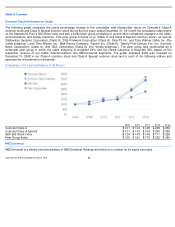Comcast 2013 Annual Report Download - page 42
Download and view the complete annual report
Please find page 42 of the 2013 Comcast annual report below. You can navigate through the pages in the report by either clicking on the pages listed below, or by using the keyword search tool below to find specific information within the annual report.
Table of Contents
intended to legitimize some of these practices. There can be no assurance as to whether the courts will ultimately invalidate these
practices or the pending legislation will be enacted, or how any such rulings or legislation would ultimately affect our businesses.
Piracy and other unauthorized uses of content are made easier, and the enforcement of intellectual property rights more
challenging, by technological advances allowing the conversion of programming, films and other content into digital formats, which
facilitates the creation, transmission and sharing of high-
quality unauthorized copies. In particular, piracy of programming and films
through unauthorized distribution on DVDs, peer-to-
peer computer networks and other platforms continues to present challenges
for our cable networks, broadcast television and filmed entertainment businesses. While piracy is a challenge in the United States,
it is particularly prevalent in many parts of the world that lack developed copyright laws, effective enforcement of copyright laws and
technical protective measures like those in effect in the United States. If any U.S. or international laws intended to combat piracy
and protect intellectual property rights are repealed or weakened or are not adequately enforced, or if the legal system fails to adapt
to new technologies that facilitate piracy, we may be unable to effectively protect our rights, and the value of our intellectual
property may be negatively impacted and our costs of enforcing our rights may increase. See “Business –
Legislation and
Regulation – Other Areas of Regulation – Intellectual Property” above for additional information.
We rely on network and information systems and other technologies, as well as key properties, and a disruption, cyber
attack, failure or destruction of such networks, systems, technologies or properties may disrupt our businesses.
Network and information systems and other technologies, including those related to our network management, customer service
operations and programming delivery, are critical to our business activities. Network and information systems-
related events, such
as computer hackings, cyber attacks, computer viruses, worms or other destructive or disruptive software, process breakdowns,
denial of service attacks, malicious social engineering or other malicious activities, or any combination of the foregoing, or power
outages, natural disasters, terrorist attacks or other similar events, could result in a degradation or disruption of our services,
excessive call volume to call centers or damage to our properties, equipment and data. These events also could result in large
expenditures to repair or replace the damaged properties, networks or information systems or to protect them from similar events in
the future. Further, any security breaches, such as misappropriation, misuse, leakage, falsification or accidental release or loss of
information maintained in our information technology systems, including customer, personnel and vendor data, could damage our
reputation and require us to expend significant capital and other resources to remedy any such security breach. We may provide
certain confidential, proprietary and personal information to third parties in connection with our businesses, and while we obtain
assurances that these third parties will protect this information, there is a risk that this information may be compromised. Moreover,
the amount and scope of insurance we maintain against losses resulting from any such events or security breaches may not be
sufficient to cover our losses or otherwise adequately compensate us for any disruptions to our businesses that may result, and the
occurrence of any such events or security breaches could have a material adverse effect on our businesses.
The risk of these systems-
related events and security breaches occurring continues to intensify, in part because we maintain
certain information necessary to conduct our businesses in digital form stored on cloud servers. In the ordinary course of our
business, there are frequent attempts to cause such systems-
related events and security breaches, and we have experienced a
few minor systems-
related events that, to date, have not resulted in any significant degradation or disruption to our network or
information systems or our services or operations. While we develop and maintain systems seeking to prevent systems-
related
events and security breaches from occurring, the development and maintenance of these systems is costly and requires ongoing
monitoring and updating as technologies change and efforts to overcome security measures become more sophisticated. Despite
these efforts, there can be no assurance that these events and security breaches will not occur in the future or will not have an
adverse effect on our businesses.
37
Comcast 2013 Annual Report on Form 10
-
K


